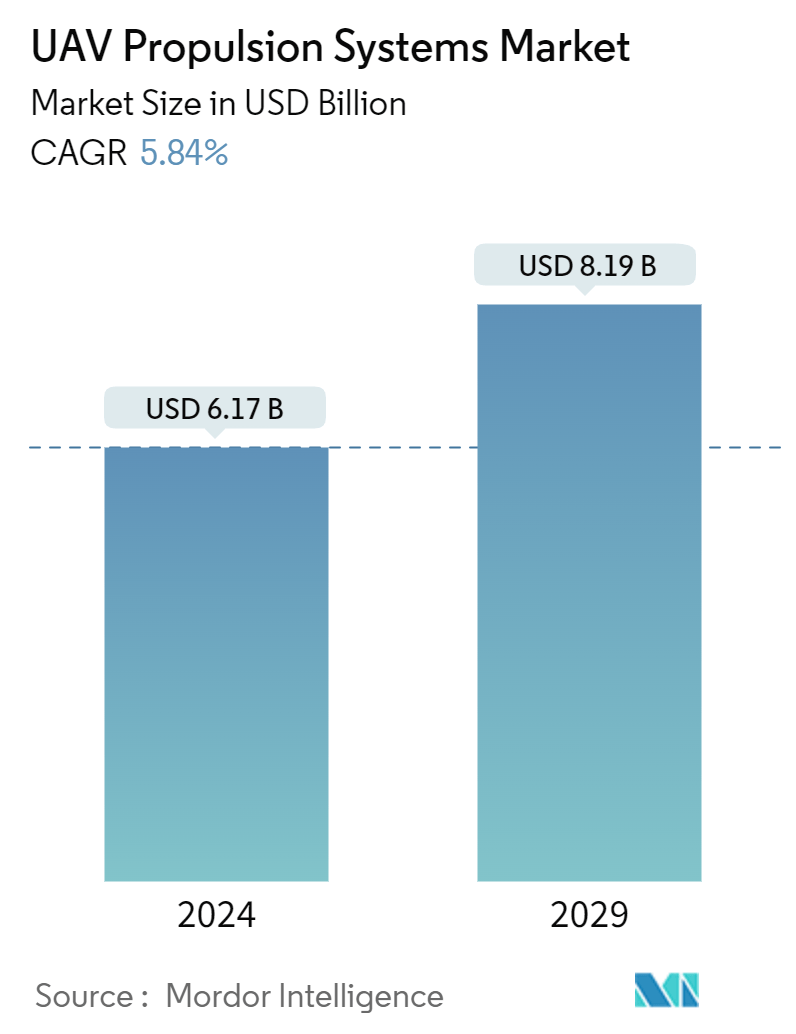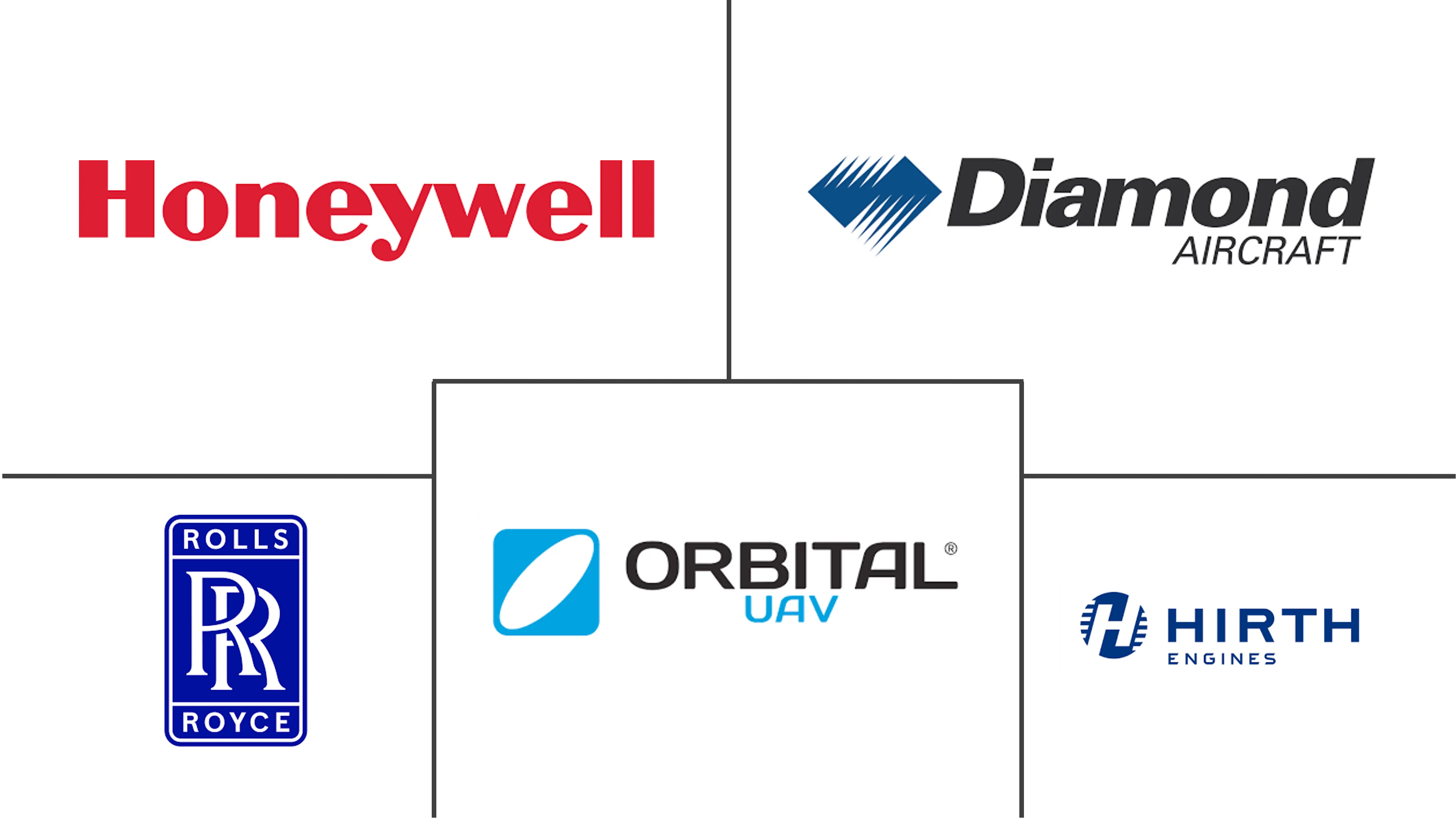
| Study Period | 2019 - 2029 |
| Market Size (2024) | USD 6.17 Billion |
| Market Size (2029) | USD 8.19 Billion |
| CAGR (2024 - 2029) | 5.84 % |
| Fastest Growing Market | Asia Pacific |
| Largest Market | North America |
| Market Concentration | Medium |
Major Players
*Disclaimer: Major Players sorted in no particular order |
UAV Propulsion System Market Analysis
The UAV Propulsion Systems Market size is estimated at USD 6.17 billion in 2024, and is expected to reach USD 8.19 billion by 2029, growing at a CAGR of 5.84% during the forecast period (2024-2029).
Over the years, the usage of drones has penetrated several applications in the commercial sector, such as aerial photography, express shipping, and delivery, gathering information or supplying essentials for disaster management, geographical mapping of inaccessible terrain and locations, building safety inspections, precision crop monitoring, unmanned cargo transport, law enforcement and border control surveillance, storm tracking, and forecasting hurricanes and tornadoes. As the customization of commercial UAVs is relatively cheap, it paves the way for new functionalities in a wide array of niche spaces. For instance, sophisticated UAVs are being deployed to fertilize crop fields on an automated basis, monitor traffic incidents, and survey hard-to-reach places.
The inherent benefits of integrating an electric-propulsion system to different UAV platforms are also driving the adoption of electric propulsion technologies much faster than their other counterparts. For instance, an electrical propulsion system provides more flexibility in the installation of machinery as they are compact, and due to the absence of several moving components of the drivetrain, they weigh less and, hence, contribute toward weight savings and endurance enhancement of a particular UAV model. Besides, the emergence of global green emission initiatives has encouraged the adoption of eco-friendly propulsion technologies, such as electric propulsion.
UAVs have evolved into increasingly capable platforms deployed for various applications. The capability to fight effectively in urban areas against widely dispersed forces while minimizing collateral damage and achieving information superiority has enabled UAVs to play a more significant role in critical missions. The endurance of a UAV is influenced by the propulsion technology used and depends on the aerodynamic design and amount of fuel carried. The market players have designed several variants of piston engines and electric motors to fulfill the energy requirements of a large variety of UAVs.
The potential benefits of a propulsion system are measured by their impact on the costs of the whole UAV. Lightweight, more fuel-efficient engines permit the usage of expensive payloads for a given mission without significantly affecting the size and price of the UAV. In recent years, the electric propulsion system has gained more popularity among small or mini-UAVs for its apparent advantages: quiet operation, easy and safe to handle and store, precise power management, and control.
UAV Propulsion System Industry Segmentation
The propulsion system of a UAV produces and supplies the necessary power to ensure continuous flight. While conventional UAV propulsion systems store energy in the form of fuel and utilize an internal combustion (IC) engine to drive the propellers, an electric propulsion system utilizes energy storage devices, such as batteries and fuel cells. In a hybrid configuration, two propulsion technologies are integrated onboard a UAV that works in tandem to eliminate the performance limitations of individual propulsion systems. The market forecast is based on the line-fit installations of propulsion systems integrated onboard the various types of UAVs being delivered across the world.
The UAV propulsion systems market is segmented by type, application, UAV type, and geography. By type, the market is segmented into conventional, hybrid, and full-electric. By application, the market is segmented into civil, commercial, and military. By UAV type, the market is segmented into micro, mini, tactical, MALE, and HALE. The report also covers the market sizes and forecasts for the UAV propulsion systems market in major countries across different regions. For each segment, the market size is provided in terms of value (USD).
| Conventional |
| Hybrid |
| Full-electric |
| Civil and Commercial |
| Military |
| Micro UAV |
| Mini UAV |
| Tactical UAV |
| MALE UAV |
| HALE UAV |
| North America | United States |
| Canada | |
| Europe | United Kingdom |
| France | |
| Germany | |
| Rest of Europe | |
| Asia-Pacific | China |
| India | |
| Japan | |
| South Korea | |
| Rest of Asia-Pacific | |
| Latin America | Brazil |
| Mexico | |
| Rest of Latin America | |
| Middle East and Africa | United Arab Emirates |
| Saudi Arabia | |
| Qatar | |
| South Africa | |
| Rest of Middle East and Africa |
UAV Propulsion Systems Market Size Summary
The UAV propulsion systems market is experiencing significant growth, driven by the increasing adoption of drones across various commercial sectors. These systems are integral to the expanding use of UAVs in applications such as aerial photography, disaster management, and precision agriculture. The market is witnessing a shift towards electric propulsion technologies due to their compactness, weight savings, and alignment with global green emission initiatives. This transition is further supported by the development of alternative fuels like hydrogen fuel cells, which offer improved reliability and efficiency for UAV operations. The market's evolution is also influenced by advancements in propulsion technologies, including piston engines and electric motors, which cater to the diverse energy requirements of UAVs.
The Asia-Pacific region is poised to lead the demand for UAV propulsion systems, fueled by military and commercial applications and significant investments in drone start-ups. The market is semi-consolidated, with key players like Orbital Corporation Limited, Diamond Aircraft Industries GmbH, and Rolls-Royce plc driving innovation and competition. These companies are focusing on developing advanced propulsion systems and integrating new technologies, such as 3D printing, to enhance UAV capabilities. Collaborative efforts and strategic partnerships are also shaping the market, as seen in recent agreements and research grants aimed at improving UAV performance and expanding their operational range.
UAV Propulsion Systems Market Size - Table of Contents
1. MARKET DYNAMICS
- 1.1 Market Overview
- 1.2 Market Drivers
- 1.3 Market Restraints
-
1.4 Porter's Five Forces Analysis
- 1.4.1 Bargaining Power of Suppliers
- 1.4.2 Bargaining Power of Buyers/Consumers
- 1.4.3 Threat of New Entrants
- 1.4.4 Threat of Substitute Products
- 1.4.5 Intensity of Competitive Rivalry
2. MARKET SEGMENTATION
-
2.1 Engine Type
- 2.1.1 Conventional
- 2.1.2 Hybrid
- 2.1.3 Full-electric
-
2.2 Application
- 2.2.1 Civil and Commercial
- 2.2.2 Military
-
2.3 UAV Type
- 2.3.1 Micro UAV
- 2.3.2 Mini UAV
- 2.3.3 Tactical UAV
- 2.3.4 MALE UAV
- 2.3.5 HALE UAV
-
2.4 Geography
- 2.4.1 North America
- 2.4.1.1 United States
- 2.4.1.2 Canada
- 2.4.2 Europe
- 2.4.2.1 United Kingdom
- 2.4.2.2 France
- 2.4.2.3 Germany
- 2.4.2.4 Rest of Europe
- 2.4.3 Asia-Pacific
- 2.4.3.1 China
- 2.4.3.2 India
- 2.4.3.3 Japan
- 2.4.3.4 South Korea
- 2.4.3.5 Rest of Asia-Pacific
- 2.4.4 Latin America
- 2.4.4.1 Brazil
- 2.4.4.2 Mexico
- 2.4.4.3 Rest of Latin America
- 2.4.5 Middle East and Africa
- 2.4.5.1 United Arab Emirates
- 2.4.5.2 Saudi Arabia
- 2.4.5.3 Qatar
- 2.4.5.4 South Africa
- 2.4.5.5 Rest of Middle East and Africa
UAV Propulsion System Market Research FAQs
How big is the UAV Propulsion Systems Market?
The UAV Propulsion Systems Market size is expected to reach USD 6.17 billion in 2024 and grow at a CAGR of 5.84% to reach USD 8.19 billion by 2029.
What is the current UAV Propulsion Systems Market size?
In 2024, the UAV Propulsion Systems Market size is expected to reach USD 6.17 billion.


